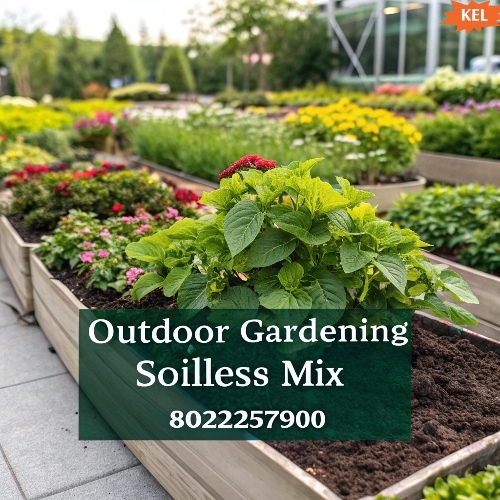Outdoor Gardening Soilless Mix
Gardening is a practice that has been very satisfying for the gardener, providing clean air, the beauty of nature, and a closer relationship with nature. The soil has been the main vehicle for growing plants, no doubt. Nevertheless, the trend of soilless mix has been gradually gaining popularity among advanced gardening practices, mostly for the outdoor gardening. This particular medium for growing gives the perfect combination of nutrients, water holding capacity, and aeration, thus, allowing the gardener to have healthy and fruitful plants.
This article is an introduction to the practice of outdoor gardening with a soilless mix, discussing the basic concepts, benefits, uses, components, mode of preparation, and how these relate to ecological gardening.
What Is a Soilless Mix?
A soilless mix is essentially a medium that is specifically formulated to do away with natural soil. It is a combination of both organic and inorganic materials which provides a light, porous, and nutrient-supportive environment for plants. The name of these mixes might imply differently, but they are not lacking in nutrients. In fact, they are designed in such a way as to promote the growth of plants more efficiently than soil while at the same time avoid most of the problems that are associated with the use of soil like compaction, pests, and non-uniform fertility.
In comparison to soils, nutrient availability, water retention, and drainage can be managed more effectively in a soilless medium. Therefore, it becomes suitable for outdoor gardening as the plants can get their necessary healthy base which can enable them to grow in different weather conditions.
Why Use Soilless Mix for Outdoor Gardening?
Outdoor gardening often comes with unique challenges, including poor soil quality, uneven pH levels, and susceptibility to pests and diseases. A soilless mix addresses these issues, providing several key benefits:
- Enhanced Aeration
Roots need oxygen to grow effectively. The lightweight, porous structure of soilless media ensures ample air pockets around roots, preventing suffocation and encouraging robust growth. - Superior Water Retention and Drainage
Unlike compact soils that either hold too much water or drain too quickly, soilless mixes strike the right balance. Materials like cocopeat and vermiculite absorb water efficiently, while perlite ensures quick drainage. - Weed-Free Medium
Traditional soil often contains weed seeds that compete with crops. A sterilized soilless mix is free from weeds, allowing plants to grow without unnecessary competition. - Disease Resistance
Soilborne pathogens can seriously harm plants. By eliminating natural soil, gardeners reduce the risk of root diseases and fungal infections. - Lightweight and Easy to Handle
Gardeners appreciate the convenience of soilless media since it is easy to transport, spread, and manage, particularly in large outdoor spaces. - Consistency in Growth
Because soilless mixes are manufactured under controlled conditions, they provide uniformity in structure and fertility, ensuring predictable results for every planting season.
Key Components of Outdoor Gardening Soilless Mix
Soilless media are typically blended from multiple ingredients, each offering unique properties. Here are the most common components:
- Cocopeat (Coir Pith): Derived from coconut husk, cocopeat retains water, improves aeration, and maintains a neutral pH.
- Perlite: A volcanic mineral that boosts drainage and prevents compaction.
- Vermiculite: Excellent for holding water and nutrients, ensuring availability to plant roots.
- Peat Moss: Known for high water retention, it creates a soft texture for root penetration.
- Composted Bark: Adds organic matter and enhances soil texture.
- Sand: Improves drainage and prevents waterlogging in outdoor gardens.
- Fertilizer Additives: Controlled-release nutrients are sometimes included to support plant growth.
The ratio of these materials can be adjusted depending on plant requirements and local climate conditions.
How to Use Soilless Mix in Outdoor Gardening
Integrating soilless mix into outdoor gardening is simple, but following the right process ensures the best results.
1. Preparing Containers or Beds
Whether using pots, raised beds, or large outdoor planters, ensure proper drainage holes to prevent water stagnation.
2. Filling with Soilless Medium
Fill containers with the prepared soilless mix. Avoid pressing it down firmly, as compacting reduces aeration.
3. Planting Seeds or Seedlings
Plant at the recommended depth, then cover lightly with the mix. Water gently to moisten the medium without causing displacement.
4. Fertilization
Since soilless media may not always contain enough nutrients, supplement with liquid or slow-release fertilizers.
5. Regular Watering
Because soilless mixes drain faster than heavy soils, maintain a consistent watering schedule. Adjust frequency depending on plant type and weather conditions.
6. Mulching
Applying organic mulch on the surface reduces evaporation and keeps the medium moist for longer.
Applications of Outdoor Gardening Soilless Mix
The adaptability of soilless mixes makes them suitable for a wide range of outdoor applications:
- Vegetable Gardening: Tomatoes, peppers, cucumbers, and leafy greens thrive in a balanced soilless environment.
- Flower Beds: Annuals and perennials display vibrant blooms when grown in porous, nutrient-rich media.
- Herb Gardens: Basil, mint, and rosemary flourish with consistent moisture control provided by soilless blends.
- Fruit Cultivation: Strawberries, blueberries, and small fruiting plants benefit from the aeration and drainage.
- Landscaping Projects: Decorative shrubs and ornamental plants grow healthier in controlled media.
Tips for Choosing the Right Soilless Mix
Not all mixes are the same. Here are some tips to choose the best one:
- Match the mix to your climate – areas with heavy rainfall need faster drainage, while hot regions require greater water retention.
- Select blends based on plant type – vegetables may require higher fertility, while succulents prefer sandy, well-drained media.
- Check the pH balance – most plants thrive between 5.5 and 6.5.
- Look for sterilized products to avoid contamination.
- Prefer environmentally responsible materials like cocopeat over non-renewable peat moss.
Sustainability and Soilless Gardening
One of the major advantages of soilless media is that it is a big help to the sustainable gardening. Such a media, that lessens the need for natural soil, not only saves good soil but also cuts the chances of the spread of soilborne diseases. In addition, many of the ingredients utilized in the manufacture of soil-less media, as that of cocopeat, are not only renewable but also environmentally friendly. Moreover, since these media are of low weight and can be easily moved, they help to lower the ‘green’ house gas emissions associated with gardening supply transportation.
In addition, outdoor gardeners can find that soilless cultivation has a significant environmental benefit in that it almost completely eliminates the need for pesticides. The absence of soil pests in soilless cultivation will inevitably lead to less use of pesticides, thus the practice will be more eco-friendly.
Challenges and Solutions in Using Soilless Mix
While the benefits are immense, gardeners should be aware of a few challenges:
- Nutrient Deficiency: Since natural soil minerals are absent, regular fertilization is essential.
- Cost Factor: Initial investment may be higher than traditional soil, but long-term benefits often outweigh costs.
- Watering Frequency: Because of faster drainage, plants may require more frequent watering.
- Knowledge Gap: Beginners may need guidance to adjust nutrient and irrigation practices.
By adopting proper fertilization routines, using moisture-retentive components, and monitoring plant growth, these challenges can be easily overcome.
Outdoor Gardening Soilless Mix and Commercial Horticulture
While gardening at home is the main application of soilless media, they are still essential for commercial horticulture. Professionals in the landscaping, greenhouse, and farming sectors are progressively turning to these mediums for their various advantages such as stability of results, increase of yields, and plant health. Top companies like Keltech Energies come up with innovative and quality growing solutions which satisfy the requirements of both amateurs and experts.
Final Thoughts
Outdoor gardening with a soilless mix is a new era of plant growing that merges science, ease, and eco-friendliness. When soil-related restrictions are removed, gardeners have more authority over the wellness and yield of plants. Regardless of whether they are vegetables, flowers, or herbs, soilless media guarantee deeper roots, more vivid growth, and environment-friendly methods. As gardening changes continuously, a soilless culture will still be the first choice of both, the individuals and the enterprises. By using these revolutionary growing mediums, outdoor gardeners can establish gardens that not only flourish through all seasons but also contribute to a greener future



